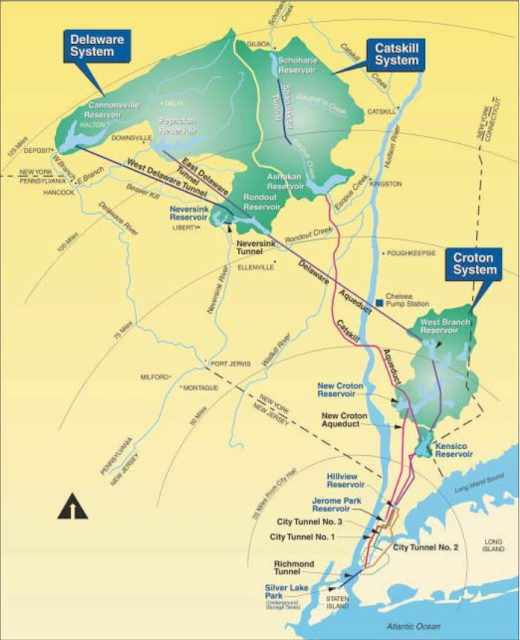Croton, Catskill & Delaware Aqueducts and some new tunnels.
The 41-mile long Old Croton Aqueduct was opened on Oct 14, 1842. "Despite its size, the capacity of the Old Croton Aqueduct could not keep up with the growth of New York City. Construction of the New Croton Aqueduct began in 1885, a few miles east and went into service in 1890. It boasted a capacity three times greater than the original Croton Aqueduct. The original Croton Aqueduct remained in service until 1958, although the northernmost portion was reopened in 1987 to provide water to Ossining. The Old Croton Aqueduct crossing of Sing Sing Kill was restored and reopened on July 20, 2013. The Broadway Bridge was again rehabilitated in 2018 at the cost of $2.8 million, which included restoring the stonework, adding new decorative lighting, and replacing the chain link fence with black metal fencing." [Bridges & Tunnels] Note that the "New" Croton Aqueduct is well into its second century of service.
 |
| Project Description, page 6 from nyc.gov |
A NY Times article about a leak in the Cannonsville Dam focuses on the people aspect of the dam. If you look at the map, Deposit, NY is downstream of the Cannonsville Dam. The residents are still bitter that 1000 people, including entire towns, were displaced over a half-century ago when the dam was built. Now they are bitter that they have to worry about the risk of living downstream of a dam. Since a big river flows right through them, they question why NYC doesn't build water purification plants (WPP) like most cities do. I also wonder why they refuse to build WPPs. It doesn't take that much flat land for a big WPP. Not only is the Chicago metro area served by just three plants, DuPage County cities also get their water from the Jardine WPP by pumping water into big water towers during the night. Is it because the Hudson is too polluted with heavy metals like mercury and pharmaceutical drugs? I can imagine that the WPP technology doesn't exist to remove those impurities. (Distillation would be way to energy intensive, and I understand that pure water tastes "funny." Our tap water generally contains trace amounts of minerals. River and lake water is around 8 grains, which is considered "just right" for laundry and showers. Before DuPage County switched from well water to lake water, our water was 30 grains.) Maintenance costs alone are rather staggering. The NYC Department of Environmental Protection plans to spend $14 billion dollars over the next 10 years to keep the system from falling apart. Yet the system provides just a billion gallons a day to NYC and 70 upstate consumers. Remember, the Jardine Plant alone produces a billion gallons of water a day. [nyc.gov, last paragraph]
(Los Angles has to pay a lot for their water supply because the closest river of any size, the Colorado River, is not big enough to supply the interested consumers.)
It is not just the towns close to the Cannonsville Dam that are at risk if a dam would fail. It has a capacity of 95.6 billion gallons, which is 1/8 of NYC's water supply. If the reservoir was full and the dam would fail, towns all the way down the Delaware River, including Philadelphia, would experience flooding. [DeBruler]
Dams I have studied so far:
 |
| safe_image for 2:15 video The $6b project started in 1970. |
%20Exclusive%20look%20deep%20inside%20NYC's%20most%20expensive%20water%20project%20ever%20-%20YouTube.png) |
| Screenshot @ 1:10 It should be fully operational in 2032. |
(Los Angles has to pay a lot for their water supply because the closest river of any size, the Colorado River, is not big enough to supply the interested consumers.)
It is not just the towns close to the Cannonsville Dam that are at risk if a dam would fail. It has a capacity of 95.6 billion gallons, which is 1/8 of NYC's water supply. If the reservoir was full and the dam would fail, towns all the way down the Delaware River, including Philadelphia, would experience flooding. [DeBruler]
Dams I have studied so far:
- Croton, 1842 and 1906, 19 BG
- Kensico, 1917
- Cannonsville, 1964, 95.6 BG
Other structures of note:
No comments:
Post a Comment